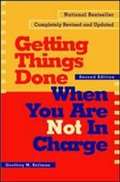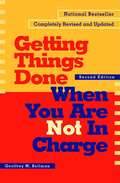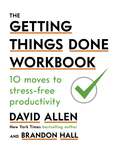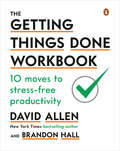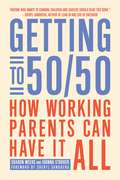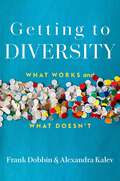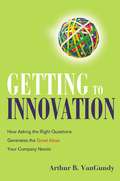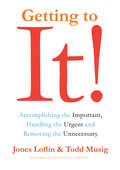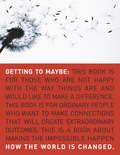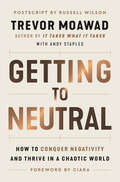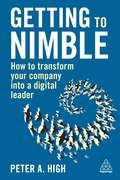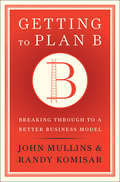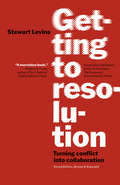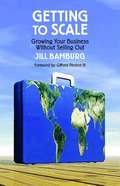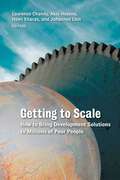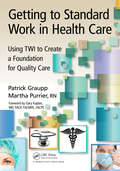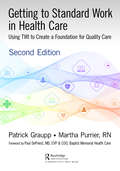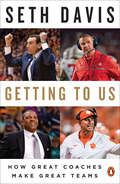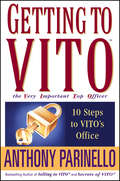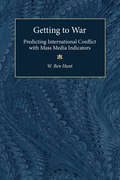- Table View
- List View
Getting Things Done for Teens: Take Control of Your Life in a Distracting World
by David Allen Mark Wallace Mike WilliamsAn adaptation of the business classic Getting Things Done for teenage readersThe most interconnected generation in history is navigating unimaginable amounts of social pressure, both in personal and online interactions. Very little time, focus, or education is being spent teaching and coaching this generation how to navigate this unprecedented amount of "stuff" entering their lives each day. How do we help the overloaded and distracted next generation deal with increasing complexity and help them not only survive, but thrive? How do we help them experience stress-free productivity and gain momentum and confidence? How do we help them achieve autonomy, so that they can confidently take on whatever comes their way? Getting Things Done for Teens will train the next generation to overcome these obstacles and flourish by coaching them to use the internationally renowned Getting Things Done methodology. In its two editions, David Allen's classic has been translated into dozens of languages and sold over a million copies, establishing itself as one of the most influential business books of its era, and the ultimate book on personal organization. Getting Things Done for Teens will adapt its lessons by offering a fresh take on the GTD methodology, framing life as a game to play and GTD as the game pieces and strategies to play your most effective game. It presents GTD in a highly visual way and frames the methodology as not only as a system for being productive in school, but as a set of tools for everyday life. Getting Things Done for Teens is the how-to manual for the next generation--a strategic guidebook for creating the conditions for a fruitful and effective future.
Getting Things Done When You Are Not in Charge: How to Succeed from a Support Position
by Geoffrey M. BellmanYou are not in charge. You may not be sure who is, but you know that you are not! Yet you want to do your work well, to succeed personally, and to satisfy the organization.
Getting Things Done When You Are Not In Charge
by Geoffrey M BellmanYou are not in charge and you want to make a difference: that is the dilemma. You may not know who is in charge in today's changing, temporary, and virtual organizations, but you know you are not! You are searching for ways to contribute through the work you do and gain some personal satisfaction in the process. This book can help you do just that. In this new edition of his classic book, Geoff Bellman shows readers how to make things happen in any organization regardless of their formal position. The new edition has been written for a wider audience, including people in both the for-profit and not-for-profit sectors, paid and volunteer workers, managers and individual contributors, contract and freelance workers. More than seventy percent of the material is brand new, including new examples, new chapters, new exercises, and much more.
The Getting Things Done Workbook: 10 Moves to Stress-Free Productivity
by David AllenAn accessible, practical, step-by-step guide that supplements Getting Things Done by providing the details, the how-to's and the practices to apply GTD more fully and easily in daily lifeThe incredible popularity of Getting Things Done revealed people's need to take control of their own productivity with a system that reduces the stress of staying on top of it all. Around the world hundreds of certified trainers and coaches are engaged full time in teaching the process, supported by a grassroots movement of Meetup groups, LinkedIn groups, Facebook groups, podcasts, blogs and dozens of apps based on it. While Getting Things Done remains the definitive way to gain perspective over work and create the mental space for creativity and mindfulness, The Getting Things Done Workbook enhances the original by providing an accessible guide to the GTD methodology in workbook form. The workbook divides the process into small, manageable segments to allow for easier learning and doing. Each chapter identifies a challenge the reader may be facing - such as being overwhelmed by too many to-do lists, a messy desk or email overload - and explains the GTD concept to address. The lessons can be learned and implemented in almost any order, and whichever is adopted will provide immediate benefits. This handy instructional manual will give both seasoned GTD users and newcomers alike clear action steps to take to reach a place of sustained efficiency.
The Getting Things Done Workbook: 10 Moves to Stress-Free Productivity
by David Allen Brandon HallAn accessible, practical, step-by-step how-to guide that supplements Getting Things Done by providing the details, the how-to's, and the practices to apply GTD more fully and easily in daily lifeThe incredible popularity of Getting Things Done revealed people's need to take control of their own productivity with a system that reduces the stress of staying on top of it all. Around the world hundreds of certified trainers and coaches are engaged full time in teaching the process, supported by a grassroots movement of Meetup groups, LinkedIn groups, Facebook groups, podcasts, blogs and dozens of apps based on it. While Getting Things Done remains the definitive way to gain perspective over work and create the mental space for creativity and mindfulness, The Getting Things Done Workbook enhances the original by providing an accessible guide to the GTD methodology in workbook form. The workbook divides the process into small, manageable segments to allow for easier learning and doing. Each chapter identifies a challenge the reader may be facing--such as being overwhelmed by too many to-do lists, a messy desk, or email overload--and explains the GTD concept to address. The lessons can be learned and implemented in almost any order, and whichever is adopted will provide immediate benefits. This handy instructional manual will give both seasoned GTD users and newcomers alike clear action steps to take to reach a place of sustained efficiency.
Getting Through Security: Counterterrorism, Bureaucracy, and a Sense of the Modern
by Mark Maguire David A. WestbrookGetting Through Security offers an unprecedented look behind the scenes of global security structures. The authors unveil the “secret colleges” of counterterrorism, a world haunted by the knowledge that intelligence will fail, and Leviathan will not arrive quickly enough to save everyone. Based on extensive interviews with both special forces and other security operators who seek to protect the public, and survivors of terrorist attacks, Getting Through Security ranges from targeted European airports to African malls and hotels to explore counterterrorism today. Maguire and Westbrook reflect on what these practices mean for the bureaucratic state and its violence, and offer suggestions for the perennial challenge to secure not just modern life, but humane politics. Mark Maguire has long had extraordinary access to a series of counterterrorism programs. He trained with covert behavior detection units and attended secret meetings of international special forces. He found that security professionals, for all the force at their command, are haunted by ultimately intractable problems. Intelligence is inadequate, killers unexpectedly announce themselves, combat teams don’t arrive quickly enough, and for a time an amorphous public is on its own. Such problems both challenge and occasion the institutions of contemporary order. David Westbrook accompanied Maguire, pushing for reflection on what the dangerous enterprise of securing modern life means for key concepts such as bureaucracy, violence, and the state. Introducing us to the “secret colleges” of soldiers and police, where security is produced as an infinite horizon of possibility, and where tactics shape politics covertly, the authors relate moments of experimentation by police trying to secure critical infrastructure and conversations with special forces operators in Nairobi bars, a world of shifting architecture, technical responses, and the ever-present threat of violence. Secrecy is poison. Government agencies compete in the dark. The uninformed public is infantilized. Getting Through Security exposes deep flaws in the foundations of bureaucratic modernity, and suggests possibilities that may yet ameliorate our situation.
Getting to 50/50
by Sheryl Sandberg Joanna Strober Sharon MeersSharon Meers and Joanna Strober are professionals, wives, and mothers. They understand the challenges and rewards of two-career households. They also know that families thrive not in spite of working mothers but because of them. You can have a great career, a great marriage, and be a great mother. The key is tapping into your best resource and most powerful ally-the man you married.After interviewing hundreds of parents and employers, surveying more than a thousand working mothers, and combing through the latest government and social science research, the authors have discovered that kids, husbands, and wives all reap huge benefits when couples commit to share equally as breadwinners and caregivers. Mothers work without guilt, fathers bond with their kids, and children blossom with the attention of two involved parents.The starting point? An attitude shift that puts you on the road to 50/50-plus the positive step-by-step advice in this book.From "baby boot camp" for new dads to exactly what to say when negotiating a leave with the boss, this savvy book offers fresh ideas to today's families offering encouragement, hope, and confidence to any woman who has ever questioned her choices regarding work and family.
Getting to 50/50: How Working Parents Can Have It All
by Joanna Strober Sharon MeersSharon Meers and Joanna Strober are professionals, wives, and mothers. They understand the challenges and rewards of two-career households. They also know that families thrive not in spite of working mothers but because of them. You can have a great career, a great marriage, and be a great mother. The key is tapping into your best resource and most powerful ally--the man you married. After interviewing hundreds of parents and employers, surveying more than a thousand working mothers, and combing through the latest government and social science research, the authors have discovered that kids, husbands, and wives all reap huge benefits when couples commit to share equally as breadwinners and caregivers. Mothers work without guilt, fathers bond with their kids, and children blossom with the attention of two involved parents. The starting point? An attitude shift that puts you on the road to 50/50--plus the positive step-by-step advice in this book. From "baby boot camp" for new dads to exactly what to say when negotiating a leave with the boss, this savvy book offers fresh ideas to today's families offering encouragement, hope, and confidence to any woman who has ever questioned her choices regarding work and family.
Getting to Diversity: What Works and What Doesn’t
by Frank Dobbin Alexandra Kalev“Too many companies don’t know how to walk the walk of diversity, equity, and inclusion. Getting to Diversity shows them how.”—Lori George Billingsley, former Global Chief DEI Officer, Coca-Cola CompanyIn an authoritative, data-driven account, two of the world’s leading management experts challenge dominant approaches to increasing workplace diversity and provide a comprehensive account of what really works.Every year America becomes more diverse, but change in the makeup of the management ranks has stalled. The problem has become an urgent matter of national debate. How do we fix it? Bestselling books preach moral reformation. Employers, however well intentioned, follow guesswork and whatever their peers happen to be doing. Arguing that it’s time to focus on changing systems rather than individuals, two of the world’s leading experts on workplace diversity show us a better way in the first comprehensive, data-driven analysis of what succeeds and what fails. The surprising results will change how America works.Frank Dobbin and Alexandra Kalev draw on more than thirty years of data from eight hundred companies as well as in-depth interviews with managers. The research shows just how little companies gain from standard practice: sending managers to diversity training to reveal their biases, then following up with hiring and promotion rules, and sanctions, to shape their behavior. Almost nothing changes. It’s time, Dobbin and Kalev argue, to focus on changing the management systems that make it hard for women and people of color to succeed. They show us how the best firms are pioneering new recruitment, mentoring, and skill training systems, and implementing strategies for mixing segregated work groups to increase diversity. They explain what a difference ambitious work–life programs make. And they argue that as firms adopt new systems, the key to making them work is to make them accessible to all—not just the favored few.Powerful, authoritative, and driven by a commitment to change, Getting to Diversity is the book we need now to address constructively one of the most fraught challenges in American life.
Getting to Innovation: How Asking The Right Questions Generates The Great Ideas Your Company Needs
by Arthur VanGundyAs an acknowledged guru in the field of creativity and innovation, Arthur VanGundy has inspired businesses in a variety of industries to generate more original, cutting-edge ideas. Getting to Innovation is a detailed guide to achieving the critical first step in formulating creative and useful ideas-i.e., asking the right questions that define the challenges facing any organization. Readers will discover: * how to write positioning and rationale statements for each challenge * how to link together multiple objectives in priority frameworks * the top 10 techniques for generating creative ideas * tips for designing and running brainstorming retreats * advice on how to select the best ideas from the many that have been generated When it comes to true innovation, it's not formulating the great ideas, but asking the right questions that will ultimately lead to results. Getting to Innovation offers the tools to help every company tap into its most inspired thinking.
Getting to It
by Jones LoflinFrom Jones Loflin and Todd Musig, the authors of Juggling Elephants, comes Getting to It--a practical guide to sorting through the many priorities in your life, showing you how to carefully and consistently evaluate what your IT (Important Thing) should be, and how to get IT done. How busy are you? In the daily struggle to get it all done, what are you forgetting? Is your mind constantly racing with lists of all the things you could and should be doing? Does your day often feel like you're treading water in an ocean of rushes and deadlines, trying to keep from drowning while handling increasing work and life demands?Don't give up--help is on the way. You just have to find your It. The Important Thing. Define It. Plan It. Focus on It. Get excited about It. Identifying It isn't just the first step in the process of getting focused and heading in the right direction, it's every step. Getting to It Accomplishing the Important, Handling the Urgent, and Removing the Unnecessary provides the necessary tools to accomplish the important, handle the urgent, and get rid of the unnecessary. Want to enjoy a more fulfilling life? Get to It.
Getting to Maybe: How the World Is Changed
by Michael Patton Frances Westley Brenda ZimmermanA practical, inspirational, revolutionary guide to social innovationMany of us have a deep desire to make the world around us a better place. But often our good intentions are undermined by the fear that we are so insignificant in the big scheme of things that nothing we can do will actually help feed the world's hungry, fix the damage of a Hurricane Katrina or even get a healthy lunch program up and running in the local school. We tend to think that great social change is the province of heroes - an intimidating view of reality that keeps ordinary people on the couch. But extraordinary leaders such as Gandhi and even unlikely social activists such as Bob Geldof most often see themselves as harnessing the forces around them, rather than singlehandedly setting those forces in motion. The trick in any great social project - from the global fight against AIDS to working to eradicate poverty in a single Canadian city - is to stop looking at the discrete elements and start trying to understand the complex relationships between them. By studying fascinating real-life examples of social change through this systems-and-relationships lens, the authors of Getting to Maybe tease out the rules of engagement between volunteers, leaders, organizations and circumstance - between individuals and what Shakespeare called "the tide in the affairs of men."Getting to Maybe applies the insights of complexity theory and harvests the experiences of a wide range of people and organizations - including the ministers behind the Boston Miracle (and its aftermath); the Grameen Bank, in which one man's dream of micro-credit sparked a financial revolution for the world's poor; the efforts of a Canadian clothing designer to help transform the lives of aboriginal women and children; and many more - to lay out a brand new way of thinking about making change in communities, in business, and in the world.From the Hardcover edition.
Getting to Neutral: How to Conquer Negativity and Thrive in a Chaotic World
by Trevor Moawad Andy StaplesForeword by CiaraIn this breakthrough book, the author of Wall Street Journal bestseller It Takes What It Takes provides life-changing, step-by-step guidance on how to successfully navigate adversity and defeat negativity by downshifting to neutral thinking. It’s easy to be positive when everything is coming up roses. But what happens when life goes sideways? Many of us lapse into a self-defeating negative spiral that makes it hard to accomplish anything. Getting to Neutral is a step-by-step guide that shows readers how to use mental conditioning coach Trevor Moawad’s innovative motivational system to defeat negativity and thrive.Neutral thinking is a judgment-free, process-oriented approach that helps us coolly assess situations in high-pressure moments. Moawad walks readers through how to downshift to neutral no matter how dire the situation. He shows us how to behave our way to success, how to determine and practice our values in a neutral framework, and how to surround ourselves with a team that helps us to stay neutral. Filled with raw, inspiring stories of how Trevor navigated health challenges with neutral thinking as well as insights drawn from some of the world’s best athletes, coaches, and leaders, Getting to Neutral will help readers learn to handle even the most complex and turbulent situations with calm, clarity, and resolve.
Getting to Nimble: How to Transform Your Company into a Digital Leader
by Peter A. HighWith increased pressure from digital natives, now is the time for established companies to address outdated and antiquated practices in order to respond quickly to the ever-increasing speed of market changes. The pace of change in business today is such that it is becoming easier to go from a legendarily high-performing company to liquidation in a short period of time. Getting to Nimble shares the stories of organizations that were able to successfully transform their people practices, processes, technology, ecosystems and strategy for the digital era. The book also covers once dominant companies like Circuit City and Kodak that neglected to change and were impaired or died as a result.Highlighting a framework to follow along with best practices that others can emulate, Getting to Nimble includes case studies from major organizations such as Capital One, FedEx, CarMax, The Washington Post, Domino's Pizza, Walmart and the country of Estonia.
Getting to Plan B
by Randy Komisar John MullinsYou have a new venture in mind. And you've crafted a business plan so detailed it's a work of art. Don't get too attached to it.As John Mullins and Randy Komisar explain in Getting to Plan B, new businesses are fraught with uncertainty. To succeed, you must change the plan in real time as the inevitable challenges arise. In fact, studies show that entrepreneurs who stick slavishly to their Plan A stand a greater chance of failing-and that many successful businesses barely resemble their founders' original idea.The authors provide a rigorous process for stress testing your Plan A and determining how to alter it so your business makes money, solves customers' needs, and endures. You'll discover strategies for:-Identifying the leap-of-faith assumptions hidden in your plan-Testing those assumptions and unearthing why the plan might not work-Reconfiguring the five components of your business model-revenue model, gross margin model, operating model, working capital model, and investment model-to create a sounder Plan B.Filled with success stories and cautionary tales, this book offers real cases illustrating the authors' unique process. Whether your idea is for a start-up or a new business unit within your organization, Getting to Plan B contains the road map you need to reach success.
Getting to Resolution: Turning Conflict Into Collaboration
by Stewart LevineOur current models for ending conflict don’t really work. They waste incredible amounts of time, money, and energy and take an enormous emotional toll on participants. The parties remain embittered, relationships are destroyed, and often the conflict just reappears later in a different form. In this second edition of his classic book, Stewart Levine offers a revolutionary alternative approach that goes beyond compromise and capitulation to provide a satisfactory resolution for everyone involved. Marriages run amuck, neighbors at odds with one another, business deals gone sour, and the pain and anger caused by corporate downsizing are just a few of the conflicts he addresses. The new edition has been thoroughly revised with new examples, new tools, new material about building trust and virtual collaboration, as well as a more global outlook. Levine rejects the adversarial legal model: "If both sides are unhappy, you probably have a good settlement." Resolution, he shows, provides relief and completeness for both sides. No one goes away unhappy. Effective resolution stops anger and resentment cold, drastically cutting the emotional cost and allowing both sides to return to productive, satisfying, functional relationships. Getting to Resolution outlines the ten principles underlying this new approach—what Levine calls “resolutionary thinking. Levine provides a detailed seven-step process for using this new mindset to resolve conflicts in a way that fosters dignity and integrity, optimizes resources, and allows all concerns to be voiced, honored, and woven into the resolution. Levine's model has a thirty-five-year track record. It has been developed, implemented, tested, and proven in business, personal, and governmental contexts. Getting to Resolution will enable readers to shift from thinking about problems, fighting, and breakdowns to thinking about collaboration, engagement, learning, creativity, and the opportunity for creating enduring value.
Getting to Scale: Growing Your Business Without Selling Out
by Jill BamburgRenowned academic and businesswoman Jill Bamburg shows how mission-driven entrepreneurs can preserve the values of their company while maintaining their growth and competitiveness in the marketplace.
Getting to Scale
by Jill BamburgBen & Jerry's. Stonyfield Farm. The Body Shop. Tom's of Maine. All leaders in the socially responsible business movement--and all eventually sold to mega-corporations. Do values-driven businesses have to choose between staying small, selling off, or selling out? Jill Bamburg says no. Based on intensive interviews with more than thirty growth-oriented, mission-driven entrepreneurs--including American Apparel, Give Something Back, Wild Planet Toys, Organic Valley Family of Farms, and Village Real Estate--her book explodes the myths of scale from both ends of the spectrum. She debunks both the limiting "small is beautiful" approach as well as the "you have to sell out to grow" mandate.
Getting to Scale
by Laurence Chandy Akio Hosono Homi Kharas Johannes LinnThe global development community is teeming with different ideas and interventions to improve the lives of the world's poorest people. Whether these succeed in having a transformative impact depends not just on their individual brilliance but on whether they can be brought to a scale where they reach millions of poor people.Getting to Scale explores what it takes to expand the reach of development solutions beyond an individual village or pilot program so they serve poor people everywhere. Each chapter documents one or more contemporary case studies, which together provide a body of evidence on how scale can be pursued. The book suggests that the challenge of scaling up can be divided into two solutions: financing interventions at scale, and managing delivery to large numbers of beneficiaries. Neither governments, donors, charities, nor corporations are usually capable of overcoming these twin challenges alone, indicating that partnerships are key to success.Scaling up is mission critical if extreme poverty is to be vanquished in our lifetime. Getting to Scale provides an invaluable resource for development practitioners, analysts, and students on a topic that remains largely unexplored and poorly understood. Contributors: Tessa Bold (Goethe University, Frankfurt), Wolfgang Fengler (World Bank, Nairobi), David Gartner (Arizona State University), Shunichiro Honda (JICA Research Institute), Michael Joseph (Vodafone), Hiroshi Kato (JICA), Mwangi Kimenyi (Brookings), Michael Kubzansky (Monitor Inclusive Markets), Germano Mwabu (University of Nairobi), Jane Nelson (Harvard Kennedy School), Alice Ng'ang'a (Strathmore University, Nairobi), Justin Sandefur (Center for Global Development), Pauline Vaughan (consultant), Chris West (Shell Foundation)
Getting to Scale
by Laurence Chandy Homi Kharas Johannes Linn Akio HosonoThe global development community is teeming with different ideas and interventions to improve the lives of the world's poorest people. Whether these succeed in having a transformative impact depends not just on their individual brilliance but on whether they can be brought to a scale where they reach millions of poor people. Getting to Scale explores what it takes to expand the reach of development solutions beyond an individual village or pilot program so they serve poor people everywhere. Each chapter documents one or more contemporary case studies, which together provide a body of evidence on how scale can be pursued. The book suggests that the challenge of scaling up can be divided into two solutions: financing interventions at scale, and managing delivery to large numbers of beneficiaries. Neither governments, donors, charities, nor corporations are usually capable of overcoming these twin challenges alone, indicating that partnerships are key to success.Scaling up is mission critical if extreme poverty is to be vanquished in our lifetime. Getting to Scale provides an invaluable resource for development practitioners, analysts, and students on a topic that remains largely unexplored and poorly understood. Contributors: Tessa Bold (Goethe University, Frankfurt), Wolfgang Fengler (World Bank, Nairobi), David Gartner (Arizona State University), Shunichiro Honda (JICA Research Institute), Michael Joseph (Vodafone), Hiroshi Kato (JICA), Mwangi Kimenyi (Brookings), Michael Kubzansky (Monitor Inclusive Markets), Germano Mwabu (University of Nairobi), Jane Nelson (Harvard Kennedy School), Alice Ng'ang'a (Strathmore University, Nairobi), Justin Sandefur (Center for Global Development), Pauline Vaughan (consultant), Chris West (Shell Foundation)
Getting to Standard Work in Health Care: Using TWI to Create a Foundation for Quality Care
by Patrick Graupp Martha PurrierAddressing the challenges involved in achieving standard work in health care, Getting to Standard Work in Health Care: Using TWI to Create a Foundation for Quality Care describes how to incorporate the most widely used Training Within Industry (TWI) method, the Job Instruction (JI) training module, to facilitate performance excellence and boost emp
Getting to Standard Work in Health Care: Using TWI to Create a Foundation for Quality Care
by Patrick Graupp Martha PurrierAddressing the challenges involved in achieving standard work in health care, Getting to Standard Work in Health Care, 2nd Edition describes how to incorporate the Training Within Industry (TWI) methods of Job Instruction (JI), Job Relations (JR) and Job Methods (JM) to facilitate performance excellence and boost employee morale in a health care organization. It not only examines the TWI methodologies but also explains how this program is as vital and applicable in today’s health care environment as it was when it was developed to train replacements of an industrial workforce off to fight in WWII. Placing this methodology squarely within the health care paradigm, the book uses easy-to-understanding terminology to describe how these methods can make all the difference in the delivery of quality health care. Supplying the foundation for successful Lean practice in health care, it clearly defines the role of standard work and leadership skills in relation to Lean health care. The updated text includes new case studies of current TWI usage in health care that demonstrates how to successfully roll out a sustainable TWI initiative. All new chapters on Job Relations and Job Methods give insight into the full scope of TWI skills development. Including examples of TWI application during the Covid pandemic, the book provides readers with the understanding of how to use these time-tested methodologies to improve training, increase engagement, and deliver continuous improvement in your organization.
Getting to Us: How Great Coaches Make Great Teams
by Seth DavisWhat makes a coach great? How do great coaches turn a collection of individuals into a coherent “us”? Seth Davis, one of the keenest minds in sports journalism, has been thinking about that question for twenty-five years. It’s one of the things that drove him to write the definitive biography of college basketball’s greatest coach, John Wooden, Wooden: A Coach’s Life. But John Wooden coached a long time ago. The world has changed, and coaching has too, tremendously. Seth Davis decided to embark on a proper investigation to get to the root of the matter. In Getting to Us, Davis probes and prods the best of the best from the landscape of active coaches of football and basketball, college and pro—from Urban Meyer, Dabo Swinney, and Jim Harbaugh to Mike Krzyzewski, Tom Izzo, Jim Boeheim, Brad Stevens, Geno Auriemma, and Doc Rivers—to get at the fundamental ingredients of greatness in the coaching sphere. There’s no single right way, of course—part of the great value of this book is Davis’s distillation of what he has learned about different types of greatness in coaching, and what sort of leadership thrives in one kind of environment but not in others. Some coaches have thrived at the college level but not in the pros. Why? What’s the difference? Some coaches are stern taskmasters, others are warm and cuddly; some are brilliant strategists but less emotionally involved with their players, and with others it’s vice versa. In Getting to Us, we come to feel a deep connection with the most successful and iconic coaches in all of sports—big winners and big characters, whose stories offer much of enduring interest and value.
Getting to VITO (The Very Important Top Officer)
by Anthony ParinelloThe author of the bestseller Selling to VITO returns with a 10-step plan for getting to the Very Important Top Officer's top of mind, top of wallet, and top of their "to-do" list Anthony Parinello's Selling to VITO introduced salespeople everywhere to the Very Important Top Officer-and taught them the precise steps of how to sell to the person with the ultimate veto power. Now, Parinello returns with Getting to VITO, a one-of-a-kind sales resource that offers proven, best-practices advice on how-to get into VITO's head, get into their budgets, and get on their team as a "trusted advisor. " Based on Parinello's own extensive sales experience-as well as the experiences of the more than one million salespeople who've studied his VITO process-Getting to VITO shows salespeople how to: * Find and pre-qualify the real VITO * Establish real value in VITO's eyes * Cut to the chase with seven different correspondence modalities * Disarm every first-call objection a salesperson may encounter * Deliver the show-stopper "elevator" pitch for every industry * One-on-one coaching from Parinello's own professional coach! Anthony Parinello (San Diego, CA) is the country's foremost expert on selling to top officers. His bestselling book and audiotape program Selling to VITO (The Very Important Top Officer) has sold more than 500,000 copies. Parinello's Secrets of VITO: Think and Sell Like a CEO was a Wall Street Journal bestseller and his most recent book Getting the Second Appointment has been accepted by his following as the new sales process of "choice. "
Getting to War: Predicting International Conflict with Mass Media Indicators
by W. Ben HuntThis book shows how to predict wars. More specifically, it tells us how to anticipate in a timely fashion the scope and extent of interstate conflict. By focusing on how all governments--democratic or not--seek to secure public support before undertaking risky moves such as starting a war, Getting to War provides a methodology for identifying a regime's intention to launch a conflict well in advance of the actual initiation. The goal here is the identification of leading indicators of war. Getting to War develops such a leading political indicator by a systematic examination of the ways in which governments influence domestic and international information flows. Regardless of the relative openness of the media system in question, we can accurately gauge the underlying intentions of those governments by a systematic analysis of opinion-leading articles in the mass media. This analysis allows us to predict both the likelihood of conflict and what form of conflict--military or diplomatic/economic--will occur.

